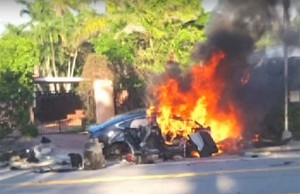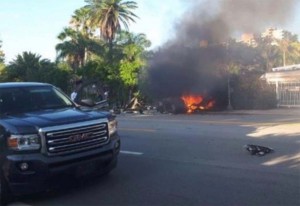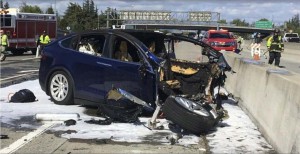
The National Transportation Safety Board launched a second investigation into a Tesla crash. This time a Model S burst into flames after spinning into a wall.
Even as federal investigators probe the cause of a fatal March crash in California, the National Transportation Safety Board is sending another team off to Florida to look into a fiery crash that killed two Ft. Lauderdale teenagers and seriously injured a third this week.
While the California probe focuses on the Tesla Autopilot system in use at the time of the crash, the new investigation aims to find out why the battery pack in the Model S sedan the teens were riding in burst into flames after the vehicle spun out of control into a wall.
“NTSB has a long history of investigating emerging transportation technologies, such as lithium-ion battery fires in commercial aviation, as well as a fire involving the lithium-ion battery in a Chevrolet Volt in collaboration with the National Highway Traffic Safety Administration,” noted NTSB Chairman Robert Sumwalt in a statement.
The two investigations add to the growing list of concerns swirling around Tesla and the newest probe comes barely a week after the automaker’s CEO Elon Musk came under fire for his handling of a conference call with stock analysts during which he dismissed several questions as “boring.”
(Musk looks beyond Model 3 problems, but creates some headache in the process. Click Here for the story.)
Tesla is also facing a series of lawsuits and other legal matters, including charges of racial discrimination and a National Labor Relations Board probe of allegations that Tesla fired nearly 1,000 workers at its Fremont, California assembly plant because they supported an effort to unionize the factory.
That plant itself has been struggling through what Musk has referred to as “production hell,” with output of the critical new Model 3 battery-sedan running well below plan. In turn, that resulted in Tesla’s worst loss ever during the first quarter of 2018 – though it actually did manage to slightly beat Wall Street forecasts.
In the minutes leading up to the March crash that killed the driver of a Tesla Model X, the SUV was confirmed to be operating in semi-autonomous Autopilot mode, though Musk has criticized the driver, noting he had received advance warning to take manual control of the vehicle.
In the latest incident, the 2014 Model S was being driven manually, albeit above the residential zone’s 35 mph speed limit.
Tesla issued a statement noting that if Autopilot had been engaged, “it would have limited the vehicle’s speed to 35 mph or less on this street, which is inconsistent with eyewitness statements and the damage to the vehicle.” The automaker also noted that it had “not yet been able to retrieve the logs from the vehicle” that would have offered more precise information about how it was being driven immediately before the crash occurred.
With the police not yet saying more than that excessive speed may have been a factor, the focus of concern – and the NTSB probe – is why the Model S caught fire and burned so dramatically.
(For more on Tesla’s first-quarter earnings, Click Here.)
As Musk pointed out following a separate Model S crash and battery-related fire that killed two in Indianapolis, vehicle fires are far from uncommon. Data indicate there are hundreds a day involving gas-powered automobiles. But Tesla has routinely attempted to portray its products as being extremely safe. After several early fires were triggered by road debris damaging the bottom of the battery pack used in the Model S, the automaker added new shielding the reduce the likelihood of that happening again.
But experts point out that lithium-ion batteries like those used in Tesla products can be prone to ignite and create difficult-to-control fires when their cells are damages. Commercial airlines have put in place severe restrictions on the shipment of lithium batteries in their cargo holds.
A lot could be riding on what the NTSB rules on the two Tesla crashes it is investigating. A 2016 Florida crash that killed a former Navy SEAL was originally blamed on the driver, 40-year-old Joshua Brown following a probe by the National Highway Traffic Safety Administration. But the NTSB issued a separate report that spread the blame to Tesla, noting that its Autopilot system failed to recognize the truck that cut in front of Brown’s Model S because its white side was hard to distinguish from a bright sky.
Tesla ordered major changes to the Autopilot system after that report was released, among other things, severing ties to Israeli-based Mobileye, the supplier of its in-vehicle camera system. The March fatal crash California could raise concerns about updates made to Autopilot.
Tesla doesn’t need to have questions raised about its safety even as it struggles to boost Model 3 production. The company reportedly has more than 400,000 advance reservations, but some have apparently cancelled those orders in frustration, with deliveries for just that backlog expected to push well into 2019, if not later. Questions about Tesla safety could impact what other reservation holders might do, never mind potential buyers who are just looking into Tesla products now.
(What’s really under the skin of the Tesla Model 3? Click Here to find out.)
In turn, that could raise further concerns among investors who have sharply driven down the company’s stock in recent months.



This latest crashand burn makes a liar out of Musk, who had claimed in the previous fire that Tesla batteries are designed to burn slowly, allowing the occupants to escape the vehicle. Of course, often in a wreck, the occupants cannot escape, especially when a Tesla is involved. And if Tesla is claiming that everyone should always use the Autopilot system, why does Tesla build cars that accelerate rapidly and can exceed any speed limit? One of Tesla’s big selling points are its car’s speed. That is not consistent with Tesla’s claims that it is trying to build safe cars. Tesla is a really stupid company, run by a stupid jerk. Tesla’s battery design is quite obviously defective.
The witch hunt continues.
Teenagers have been killing themselves in cars since there were teenagers driving cars. I don’t recall thedetroitbureau covering other teenager related car deaths/fires; (Teens were involved in 14,000 fatal crashes during the last five years)
When the advocates have their way and every car out there has a ton of lithium stuffed into every cranny, maybe battery fires will be common enough not to make the news (like Chicago shootings). Until then, join the bandwagon.
More:
https://www.theguardian.com/world/2018/may/09/bus-explodes-rome-historic-centre-italy-investigation
The busses are 15 years old. How old are the Teslas?